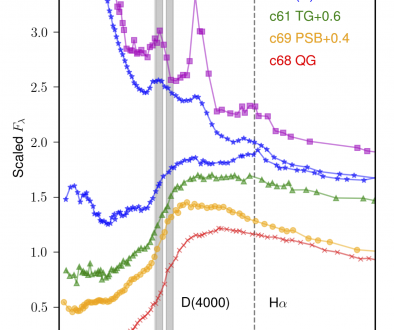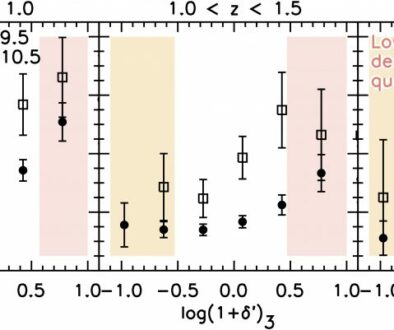Papovich 2018 Summary
Studies show the rate of quenching and the quiescent galaxy fraction are correlated with both increasing stellar mass and local environment. In the local Universe, these effects may be separable but in the more distant Universe, the evidence suggests otherwise. With ZFOURGE we studied the effects of galaxy environment on the evolution of the stellar–mass function (SMF) over 0.2<z<2.0 using=”” the=”” fourstar=”” galaxy=”” evolution=”” (zfourge)=”” survey=”” and=”” newfirm=”” medium–band=”” (nmbs)=”” down=”” to=”” stellar–mass=”” completeness=”” limit,=”” logm∗=”” m⊙=””> 9.0 (9.5) at z = 1.0 (2.0). We compared the SMFs for quiescent and star–forming galaxies in the highest and lowest environments. For star–forming galaxies, at all redshifts there are only minor differences with environment in the shape of the SMF. For quiescent galaxies, the SMF in the lowest densities shows no evolution with redshift, other than an overall increase in number density (φ∗) with time. This suggests that the stellar–mass dependence of quenching in relatively isolated galaxies is both universal and does not evolve strongly.</z<2.0>
While at z>1.5 the SMF of quiescent galaxies is indistinguishable in the highest and lowest densities, at lower redshifts it shows a rapidly increasing number density of lower–mass galaxies, logM∗/M⊙ = 9 − 10. This evolution can account for all the redshift evolution in the shape of the total quiescent–galaxy SMF. For quiescent galaxies, the SMF at higher redshift (z > 1) requires an environmental–quenching efficiency that decreases with decreasing stellar mass at 0.5 < z < 1.5 or it would overproduce the number of lower–mass quiescent galaxies in denser environments. This favors a dominant environment process such as starvation combined with rapid gas depletion and ejection at z > 0.5 − 1.0 for galaxies in our mass range (similar to “overconsumption” models). The efficiency of this process decreases with redshift allowing other processes (such as galaxy interactions and ram–pressure stripping) to become more important at later times, z < 0.5.
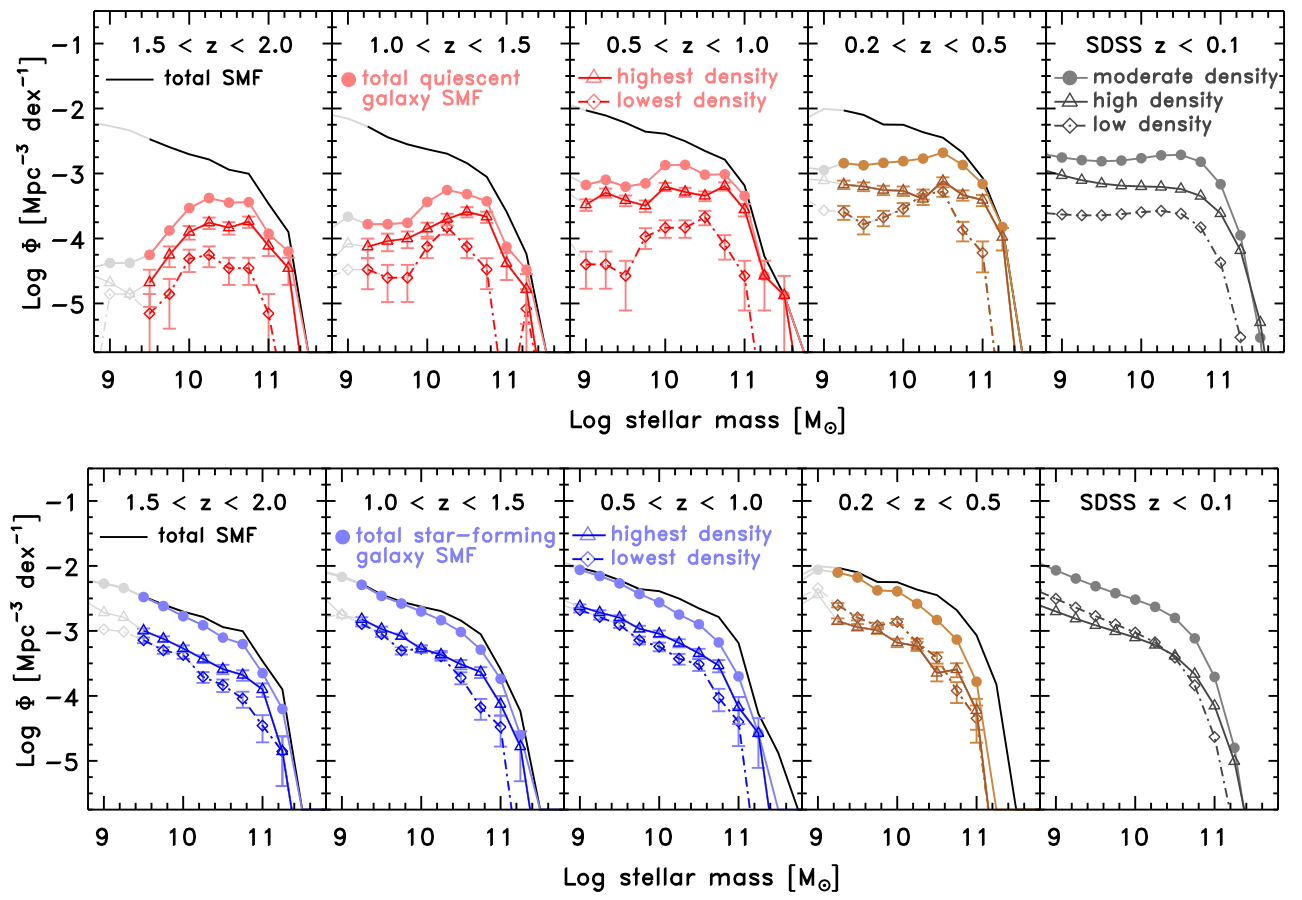
Figure. Evolution of the Stellar Mass Function (SMF) for quiescent and star-forming galaxies from the ZFOURGE survey (0.5 < z < 2.0) and NMBS (0.2 < z < 0.5). All panels show the total galaxy SMF (solid black line) as a function of redshift, as labeled. The top row of panels shows the evolution of the SMF for all quiescent galaxies, and for quiescent galaxies in the highest density quartile (D4) and lowest density quartile (D1), as labeled. The bottom row of panels shows the evolution of the SMF for all star-forming galaxies and for star-forming galaxies in D4 and D1, as labeled. Light-gray shaded points and lines show where the data fall below the stellar mass completeness for the redshifts of each panel. Error bars correspond only to Poissonian uncertainties using the number of galaxies in each data point. The right-most panels in each row show SMFs from SDSS at z < 0.1 derived in high densities, moderate densities, and low densities (Baldry et al. 2006), scaled to match the normalization of our SMFs derived from the NMBS at 0.2 < z < 0.5 (see text). The SMF for quiescent galaxies shows a dependence on density while there is no such strong dependence for the SMF of star-forming galaxies.
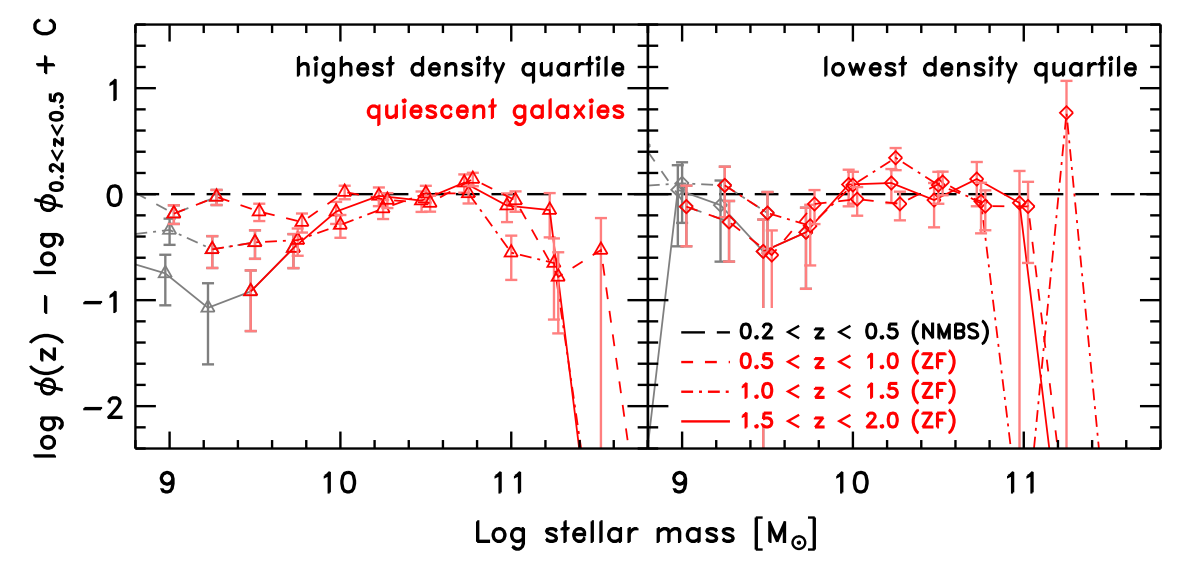
Figure. Relative evolution of the SMF for quiescent galaxies as a function of environment. The left panel shows the ratio of the SMF for quiescent galaxies in the highest density quartile (D4) in each redshift bin to the SMF for quiescent galaxies in the highest density quartile at 0.2 < z < 0.5 (the constant C acts to normalize each SMF to the same number density at logM∗/M⊙=10.6). The right panel shows the same for quiescent galaxies in the lowest density quartile (D1) The gray-shaded points and lines show data below the stellar mass completeness limit. There is no evidence that the shape of the SMF evolves for quiescent galaxies in the lowest–density quartile. In contrast, in the highest density quartile, there is rapid redshift evolution in the SMF, particularly in the relative number density of low-mass quiescent galaxies.
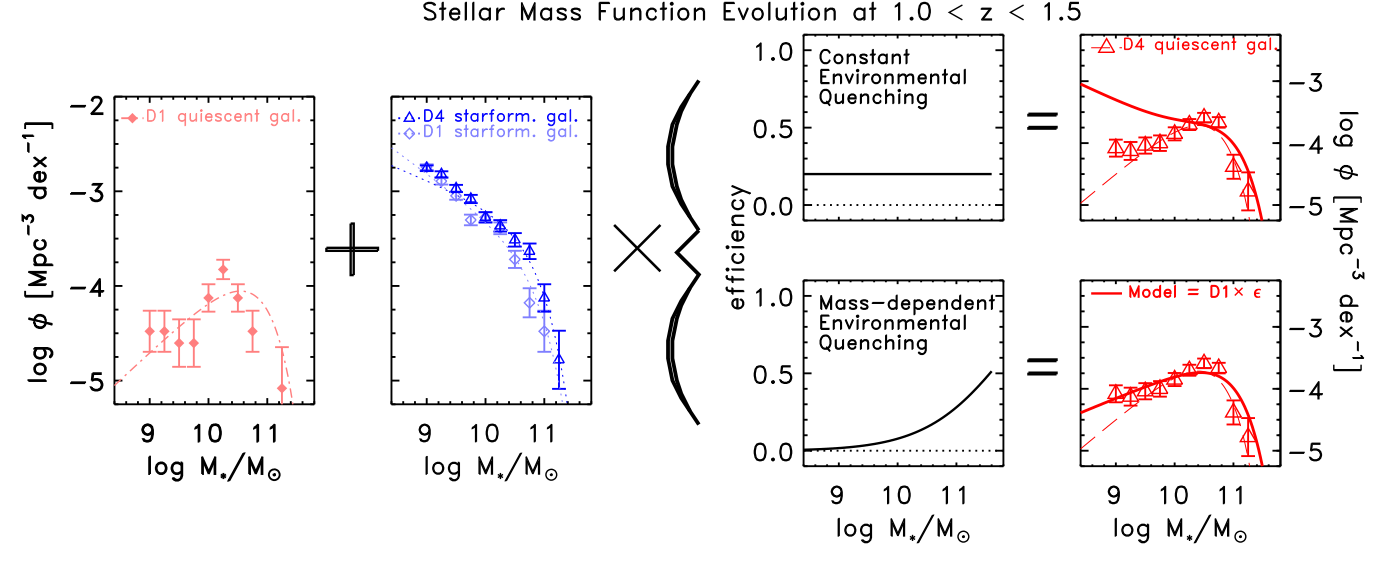
Figure. Simple experiments of the evolution of the stellar-mass function (SMF) of quiescent galaxies at 1.0 < z < 1.5 in different environments. The models demonstrate that the environmental quenching must be dependent on the stellar mass to reproduce the SMF of quiescent galaxies in different environments. The panels demonstrate an “equation”, with some fraction of star-forming galaxies being quenched by the environment and added to the quiescent–galaxy SMF in the lowest density quartile (D1) to represent the quiescent–galaxy SMF in the highest density quartile (D4), as described in Eq. 5 and 6. The left panels show the measured SMF and Schechter-model fit for quiescent and star-forming galaxies in the lowest overdensity quartile (D1) and the highest overdensity quartile (D4), as labeled. The right-hand panels show results derived by adding quenched star-forming galaxies using different environmental quenching efficiencies. The lower row of panels show an environmental quenching efficiency that depends on stellar mass from Kawinwanichakij et al. (2017), and the upper panels show results derived using an environmental quenching efficiency that is constant with stellar mass (with values from Peng et al. 2010; Kovaˇc et al. 2014). A mass-independent environmental quenching efficiency would greatly overproduce the number density of low-mass, quiescent galaxies in high overdensities at z > 0.5. The environmental quenching efficiency must decline with decreasing stellar mass at these redshifts.
